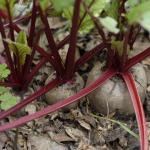Growing Beetroot, also Beets
Beta vulgaris : Amaranthaceae / the amaranth family
| Jan | Feb | Mar | Apr | May | Jun | Jul | Aug | Sep | Oct | Nov | Dec |
|---|---|---|---|---|---|---|---|---|---|---|---|
| P | P | P | P | P |
(Best months for growing Beetroot in USA - Zone 5a regions)
- P = Sow seed
- Easy to grow. Sow in garden. Sow seed at a depth approximately three times the diameter of the seed. Best planted at soil temperatures between 45°F and 77°F.
- Space plants: 8 - 12 inches apart
- Harvest in 7-10 weeks.
- Compatible with (can grow beside): Onions, Silverbeet (Swiss Chard), Lettuce, Cabbage, Dwarf Beans, Dill, Peas. Strawberries
- Avoid growing close to: Asparagus, Carrots, Sweetcorn, Spinach
Soak seeds in water 24 hours before planting so that you can separate the seeds. Thinning is nearly always required as seedlings emerge from a seedball of several seeds. If you don't thin them, you will get a number of rather pathetic plants which don't grow to an edible size. Harvest in 55 - 70 days but will keep in ground for longer.
Keep well-watered as dry beetroot develop a woody and inedible core. Tip from the Italian Gardener "Make sure the top of the beet's bulb is covered with soil; this keeps the entire bulb the same color and prevents 'corkiness' at the top of the bulb." For tasty and tender beetroot, start harvesting at golfball-size.
Culinary hints - cooking and eating Beetroot
Apart from boiling whole for salads, beetroot roast well, cut in wedges.
They also make a tasty salad grated raw with carrot and a little fresh orange juice.



Your comments and tips